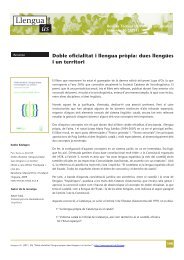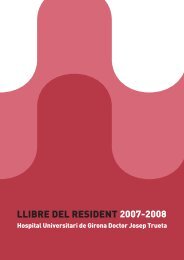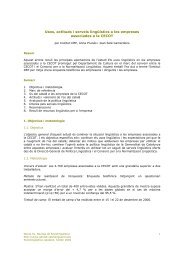Language Policy in the Russian Federation: language diversity and ...
Language Policy in the Russian Federation: language diversity and ...
Language Policy in the Russian Federation: language diversity and ...
You also want an ePaper? Increase the reach of your titles
YUMPU automatically turns print PDFs into web optimized ePapers that Google loves.
The emerg<strong>in</strong>g of nationalist movements at <strong>the</strong> heart of <strong>the</strong> RSFSR (Tatarstan, Yakutia-Sakha, Chechnya,<br />
Tuva, Buryatia, Dagestan, Nor<strong>the</strong>rn Ossetia, etc.) provoked a cha<strong>in</strong> reaction <strong>in</strong> <strong>the</strong> <strong>Russian</strong> population,<br />
<strong>in</strong> such a way that many <strong>Russian</strong> nationalist movements that arose under <strong>the</strong> protection of <strong>the</strong><br />
perestroika started, unlike <strong>the</strong>ir predecessors of <strong>the</strong> 70’s, to employ <strong>the</strong> centrifuge tactics of <strong>the</strong><br />
peripheral nationalist movements. In such a situation, faced with <strong>the</strong> <strong>in</strong>tensification of <strong>the</strong> anti-<strong>Russian</strong><br />
xenophobic feel<strong>in</strong>gs <strong>in</strong> <strong>the</strong> Transcaucasian <strong>and</strong> Centro-Asiatic Republics <strong>and</strong> <strong>the</strong> establishment of new<br />
legislations as regards <strong>language</strong>s <strong>and</strong> education that benefited autochthonous <strong>language</strong>s, <strong>the</strong> <strong>Russian</strong><br />
nationalists organized <strong>the</strong>mselves by creat<strong>in</strong>g popular fronts, as was happen<strong>in</strong>g <strong>in</strong> <strong>the</strong> Baltic countries or<br />
<strong>in</strong> Transcaucasia.<br />
This radicalization of <strong>Russian</strong> nationalism provoked a double confrontation between <strong>the</strong> RSFSR <strong>and</strong> <strong>the</strong><br />
Federated Republics, on <strong>the</strong> one h<strong>and</strong>, <strong>and</strong> between <strong>the</strong> very same RSFSR <strong>and</strong> <strong>the</strong> federal authorities,<br />
on <strong>the</strong> o<strong>the</strong>r. The fact that after <strong>the</strong> break-up of <strong>the</strong> USSR <strong>the</strong> <strong>Russian</strong> <strong>Federation</strong> still existed as a sole<br />
territorial entity with such a complex multiethnic composition gave rise among <strong>the</strong> <strong>Russian</strong> population to<br />
a feel<strong>in</strong>g that <strong>the</strong>ir country, now an orphan of reference po<strong>in</strong>ts on which to draw <strong>and</strong> construct a new<br />
identity, had simply become what was left of <strong>the</strong> USSR, once any <strong>in</strong>fluence on <strong>the</strong> o<strong>the</strong>r Federated<br />
Republics, some of which (Belarus <strong>and</strong> Ukra<strong>in</strong>e) constituted some of <strong>the</strong> symbolic references of Great<br />
Russia s<strong>in</strong>ce <strong>the</strong> X century, had been lost.<br />
The follow<strong>in</strong>g graph shows <strong>the</strong> ethnic composition <strong>in</strong> <strong>the</strong> autonomous republics of <strong>the</strong> <strong>Russian</strong><br />
<strong>Federation</strong>.<br />
Source: Own elaboration from <strong>the</strong> data provided by Natsionalnii Sostav Naseleniia SSSR (1991)<br />
The future articulation of <strong>the</strong> <strong>Russian</strong> national identity <strong>and</strong> State is extremely complex <strong>in</strong>sofar as, until<br />
now, it does not seem that <strong>the</strong>y have planned ei<strong>the</strong>r any coherent plan for development or any precise<br />
orientations on economic, social <strong>and</strong> national policies that would allow for <strong>the</strong> consolidation process of<br />
democracy <strong>in</strong> <strong>the</strong> <strong>Russian</strong> <strong>Federation</strong>. Faced with <strong>the</strong> outbreak of national <strong>and</strong> identity cohesion of post-<br />
Soviet Russia, <strong>the</strong> foundations on which <strong>the</strong> new identity <strong>and</strong> <strong>the</strong> new State should be based conta<strong>in</strong><br />
major contradictions, while <strong>the</strong> general context h<strong>in</strong>ders <strong>the</strong> articulation of a civil society traditionally<br />
underdeveloped, given <strong>the</strong> fact that, nei<strong>the</strong>r <strong>the</strong> concept of an ethnic Russia nor that of <strong>the</strong> imperial<br />
Russia can mobilize or unite <strong>the</strong> <strong>Russian</strong> citizens under <strong>the</strong> same national project; that <strong>the</strong> <strong>in</strong>tensification<br />
of <strong>the</strong> economic <strong>and</strong> regional particularities threaten to dislocate <strong>the</strong> territorial structure of <strong>the</strong><br />
<strong>Federation</strong>; that <strong>the</strong> moral <strong>and</strong> social disorientation is widespread among a population lack<strong>in</strong>g <strong>in</strong> po<strong>in</strong>ts<br />
of reference <strong>and</strong> core-values (very especially <strong>the</strong> youngsters) due to <strong>the</strong> disappearance of <strong>the</strong> old pre<strong>and</strong><br />
post-Communist values; <strong>and</strong> that <strong>the</strong> endemic economic crisis has driven tens of millions of people<br />
Noves SL. Revista de Sociol<strong>in</strong>güística 5<br />
http://www.gencat.cat/llengua/noves<br />
Sociol<strong>in</strong>güística <strong>in</strong>ternacional. Primavera 2002



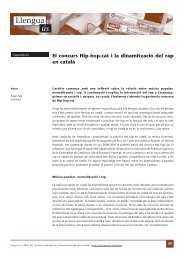
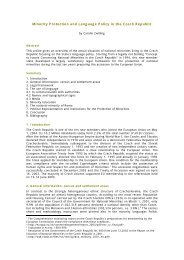
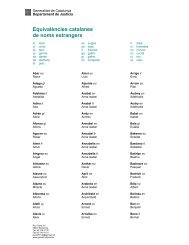
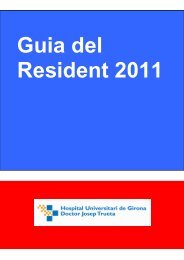

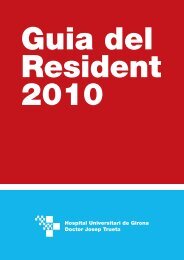

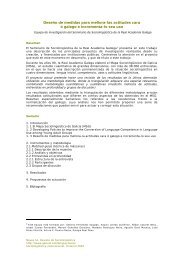
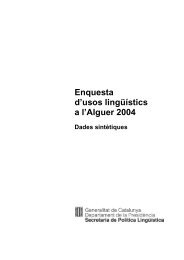
![Mestres, J.M. [et. al]. Manual d'estil: la redacció i l'edició de textos](https://img.yumpu.com/31252673/1/184x260/mestres-jm-et-al-manual-destil-la-redaccia-i-ledicia-de-textos.jpg?quality=85)
